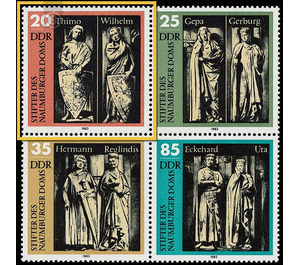 Image kindly provided by Brickset
Image kindly provided by Brickset
Founder of the Naumburg Cathedral - Germany / German Democratic Republic Set
Theme: Art & Culture
| Country | Germany / German Democratic Republic |
| Color | brown |
| Item Type | Set |
| Chronological Issue Number | 2550 |
| Chronological Chapter | GER-DDR |
| SID | 416775 |
| In 20 Wishlists | |
Founder of the Naumburg Cathedral With the reproduction of life-size statues standing in the west choir of the Naumburg Cathedral, the Ministry of Posts and Telecommunications of the German Democratic Republic issues a multi-color se-tenant with four special postage stamps. No special first-day cover envelope Special cancellation from 5 July to 4 September 1983 Founder of the Naumburg Cathedral In the west choir of the Naumburg Cathedral are twelve life-size stone statues. They are among the greatest creations of medieval German sculpture and are known throughout the world. The sitter was revered as the founder of the early Romantic Naumburg Cathedral, built in the first half of the 11th century, which was replaced by a late Romanesque building in the first half of the 13th century and enlarged by the west choir around 1250. Their foundations, first and foremost land, but also money, formed the basis of the fortune of the Naumburg cathedral church. When, about one hundred and fifty to two hundred years after the death of the founders, their statues were set up, no one knew what they had looked like, and their life, their history was then and is little known today. Ekkehard II and Uta as well as Hermann and Reglindis, two married couples, are the main founders and therefore received a special place in the west choir: in front of the service bundles between choral square and polygon. The two men were margraves, sons of the powerful margrave Ekkehard I, who was murdered in 1002, shortly before his election as German king. Hermann's wife Reglindis was a daughter of the Polish king Boleslaw I. Chrobry, Uta an Ascanian from Ballenstedt. Both couples remained childless and left their fortune to the Naumburg Church. The counts Wilhelm von Camburg and Timo von Kistritz can be clearly named on the basis of their Latin inscriptions, in German: "Count Wilhelm, one of the founders", and "Thimo von Kistritz, who donated seven goods to the (Naumburg cathedral) church". Count Wilhelm proved to be an exhibit of the Saxon princely opposition to Emperor Henry IV. Thimo's evil face turns to the murderer of his father, Margrave Ekkehard II. The names of the countesses Gerburg and Gepa were opened up by research and are still not without doubt. They go back to the interpretation of a document from the year 1249, in which eleven founders of the Naumburg Cathedral are named. However, it is not possible to match the name series of the document with the founder statues. Little is known of Gerburg except that she was married to Count Dietrich von Brehna, the brother of William of Camburg, and that she was buried next to her husband in front of the altarpiece of the early Romanesque Naumburg Cathedral. Wilhelm's wife was Gepa, who also found her grave next to her husband and before that altar. Excavations from 1960 - 1965 showed that one of the two died shortly before the birth of her child. It is generally assumed that all twelve statues - as well as the entire architecture and sculpture of the West Choir and Westlettner of the Naumburg Cathedral - were designed by a single ingenious master. Neither his name nor his circumstances are known. The research gave him the meanwhile naturalized provisional name "Naumburg master". When he came to Naumburg around the middle of the thirteenth century, he must have already been at the peak of his artistic development, so he must have been a mature man. He spent his apprenticeship in France. Traces of his activity are recognized by research in Amiens, Metz, Noyon, Reims and Strasbourg. After that he was in Mainz, where only remnants of his work have survived. Finally, his workshop of Naumburg apparently moved on to Meissen. There, she is credited with the seven life-size statues in the choir and in the entrance hall of the cathedral. The Naumburg Stifterstandbilder are unique not only because of their incomparably high artistic quality, but also because of their proximity to reality, which was quite unusual for the Middle Ages. It is almost like a miracle: Already centuries before the Renaissance, personalities of the high feudal nobility were portrayed in the western choir of the Naumburg Cathedral almost as in life. Their clothes and weapons show the fashion of the 13th century, and their faces could be portraits. They are all filled with the humanistic ethos of their ingenious creator, the Naumburg master.

